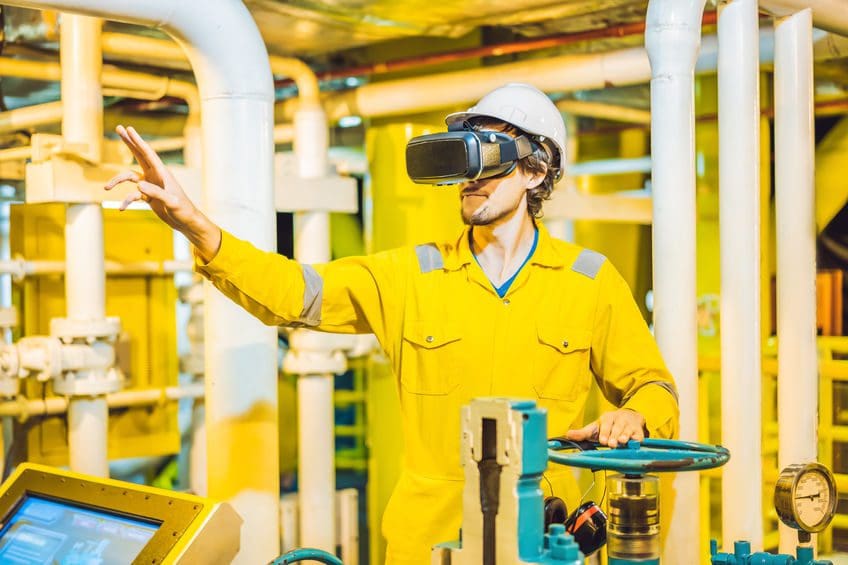Oil and gas companies are finding innovative ways to capitalise on the benefits of virtual reality (VR) technology, according to GlobalData, a leading data and analytics company.
The company’s latest report Virtual Reality in Oil & Gas – Thematic Research details how oil and gas companies using VR for subsurface studies, training and simulation, and for developing and improvising processes and products.
Listed below are the leading oil and gas companies adopting virtual reality trends, as identified by GlobalData.
Baker Hughes (GE)
Baker Hughes, a GE company, deploys VR technology to simulate oil and gas facilities within the training rooms. VR helps the company to focus on the digital design of the equipment to the minute details. It offers a higher level of accuracy and clarity about the equipment and working mechanism before the installation phase.
BP Plc
Virtual reality aids BP’s workforce to become well-trained for real-life challenges. BP, in collaboration with Maersk Training, has established a platform to enhance the knowledge of offshore drilling teams. Using simulation facilities in Svendborg, Denmark, and Houston, Texas, BP has pioneered in creating physical conditions during drilling activities.
Chevron
Chevron uses virtual reality at its El Segundo refinery in California to reduce considerable time and money spent on the maintenance process. VR goggles simulate the refinery equipment and sensor data superimposed on the 3D model, allows a technician to identify the problem and provide solutions promptly.
ConocoPhillips
ConocoPhillips embraces virtual reality to make better utilization of its existing communication and visualization technologies. The company’s Norway division has established Onshore Drilling Centre (ODC) to operate drilling activities in the North Sea. The ODC includes a 3D visualization suite to create a virtual team consisting of domain experts. The virtual team evaluates real-time data along with 3D visualization of downhole drilling equipment.
Equinor
In a joint development between Oslo-based Hydro and Bergen-based Christian Michelsen Research (CMR) institute, the team designed a 3D simulator using VR technology – known as ‘Cave’ – to support oil and gas operations. Equinor is incorporating this technology to create a 3D simulation of offshore assets and operations. Wearing 3D glasses, the geophysicists, geologists and drilling engineers can study geologic structures in minute detail and observe the various layers of oil, gas, and water present in the reserves.
ExxonMobil
At its research center in Qatar, ExxonMobil launched a 3D immersive training platform in collaboration with EON Reality to enhance field training methods. The platform creates a virtual plant environment to provide knowledge about equipment and processes to plant operators and engineers. The simulated facility mimics a variety of real-life scenarios, such as unplanned shutdown, abnormal operation, and emergency response in a safe, controlled environment.
Gazprom
Gazprom is using VR technology in its marketing and distribution operations to enhance customer engagement. In order to enrich the user experience and bridge the gap between end-user and company, Gazprom has introduced a VR-enabled platform that depicts how fuel is being made available to the end-user. With the help of VR glasses, consumers at Gazprom-operated filling stations can experience the entire fuel distribution value chain on a short virtual tour.
Halliburton
Halliburton, one of the world’s largest oilfield services companies, is partnering with Microsoft to transform oil and gas operations using virtual reality. The company is leveraging Microsoft technologies to enhance its ability to study oil and gas operations with new dimensions. The collaboration is helping in simulation and 3D modeling of oil and gas reserves and creating designs for digital representation of physical assets.
Royal Dutch Shell
Shell is deploying virtual reality along with 3D simulation for deepwater safety training to its workforce stationed at the Malikai project, offshore Malaysia. Training on a simulated environment is helping technicians to deal with potential hazards due to unsafe actions and understand the steps to overcome any unforeseen event.
Saudi Aramco
The adoption of VR technology is proving to be quite beneficial for Saudi Aramco in undertaking training exercises. Its employees are being trained to operate the critical equipment in oil and gas facilities in the correct way. In collaboration with Eon Reality Inc., the company has built a practical training platform, which demonstrates different processes that need to be adopted in real-life situations at an oil and gas facility.
Sinopec
A strategic partnership between Sinopec and Siemens has led to the adoption of digital technologies in the company’s petrochemical plants. One of the outcomes of this partnership is the Comos Walkinside virtual reality platform, which is helping to propel the company to develop and test functional modules of petrochemical plants in a simulated scenario.





